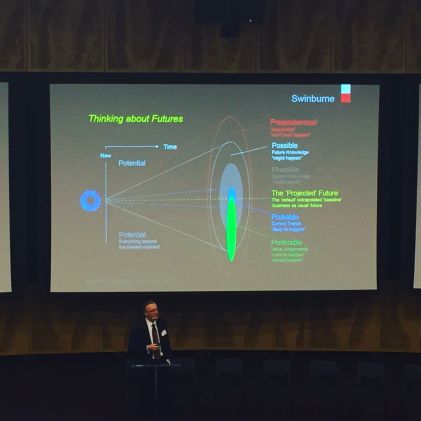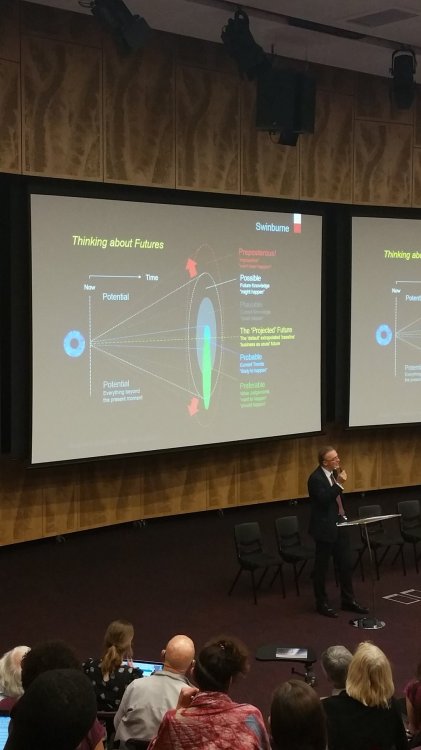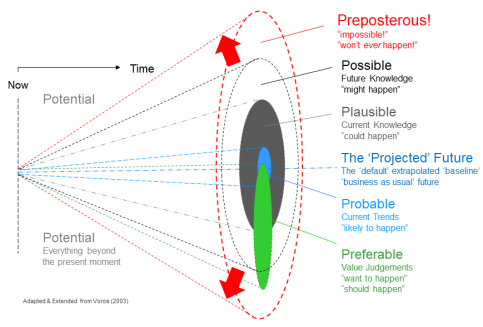 In my futures work, I use a cone diagram (above,* and again below**) to show how our judgements about ideas about the future tend to fall into a number of categories:
In my futures work, I use a cone diagram (above,* and again below**) to show how our judgements about ideas about the future tend to fall into a number of categories:
(This discussion has since been updated in another post.)
Potential – everything beyond the present moment is a potential future, and it includes the “dark” area outside the edges of the cone that we cannot even imagine (yet), and so we are usually not aware of these explicitly, only implicitly, through an (often grudging) awareness of our ignorance. This category comes from the assumption that the future is not pre-determined, inevitable or “fixed”, which is the foundational axiom of Futures Studies.
Projected – the default, business as usual, extrapolated “continuation of the past through the present” “baseline” future.
Probable – those we think are “likely to” happen, usually based on current trends.
Plausible – those we think “could” happen based on our current understanding of how the world works (physical laws, social processes, etc).
Possible – these are those that we think “might” happen, based on some future knowledge we do not yet possess, but which we might possess someday (e.g., warp drive).
Preferable – those we think “should” or “ought to” happen – normative value judgements, as opposed to the mostly cognitive, above. There is also of course the converse – the un-preferred futures – but we generally don’t tend to use this derived specialised sub-category as much.
And, perhaps the most important of all:
Preposterous! – these are the futures we judge to be “impossible”, or that will “never” happen. This category arose from two main influences: Arthur C. Clarke’s Second Law – “the way to discover the limits of the possible is to move beyond them into the impossible” – and futurist James A. (Jim) Dator’s Second Law of the Future – “any useful idea about the future should appear ridiculous” (i.e., otherwise it is not new enough and not stretching our thinking enough beyond the conventional).
The judgement of “impossibility” or that something will “never” happen usually arises from the crossing of some unspoken assumption(s), so it is useful to examine the assumption base upon which the judgement of preposterousness is being made, and to examine whether that assumption base still holds true.

I’d like to call the Possible/Preposterous boundary the “Clarke-Dator Discontinuity”, or just the “Clarke-Dator Boundary”, in homage to these two fearless futures thinkers (see the image above** or the diagram below, showing the red arrows indicating the expansion of thinking into this zone).

Preposterous! futures will be a category for posts dedicated to trying to expand thinking about the future beyond the merely “possible” and fully into the realm of the (so-called) impossible; in other words, exploring the territory beyond the Clarke-Dator Boundary in the Futures Cone – the boundary of the Possible and the Preposterous! Some of the most important changes in human society and history have arisen from things thought to be totally preposterous. So let us cheerfully explore the vast territory of preposterousness beyond the Clarke-Dator Boundary!
—
* (Thanks to Clare Cooper [Twitter: @clare_m_cooper] for the ‘action shot’ above of my presentation at the Big History Institute Anthropocene conference on 11 Dec 2015)
** (Thanks to Bridgette Engeler [Twitter: @incognitosum] for the image taken a moment later showing the arrows indicating the expansion of thinking beyond the Clarke-Dator Boundary.
Hi Joe,
Just got news of this through LinkedIn; I shall be following.
ian
LikeLike